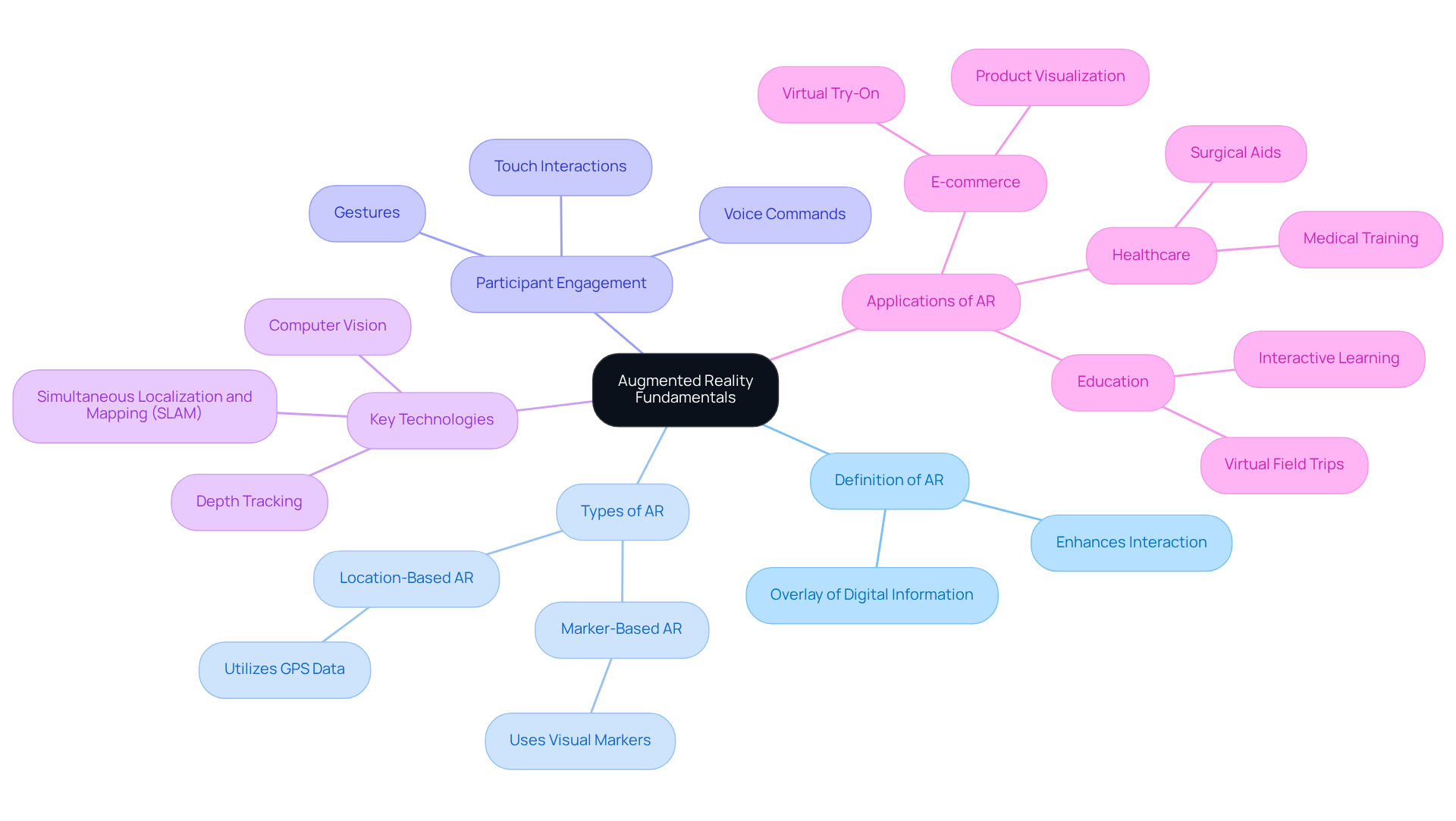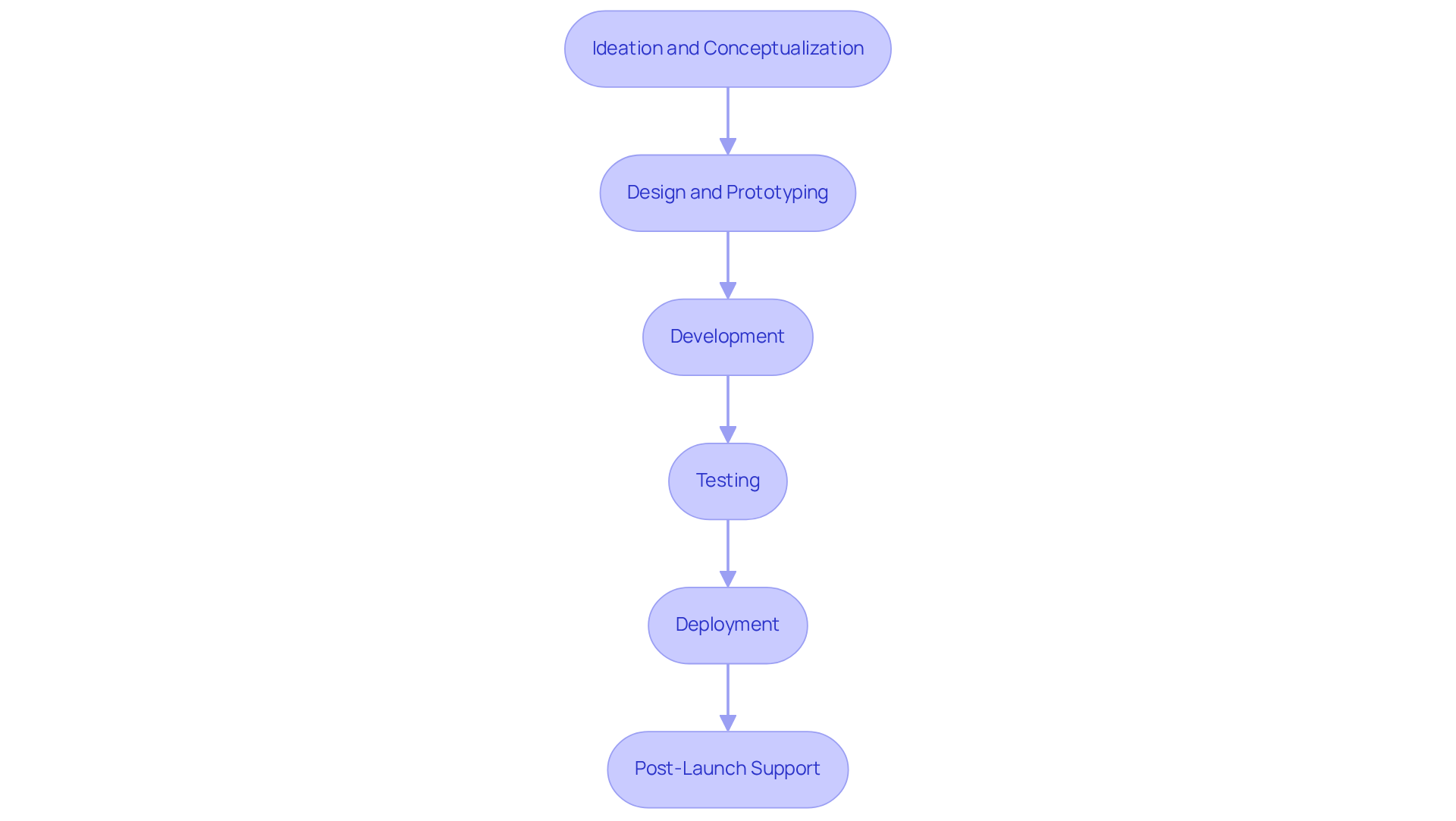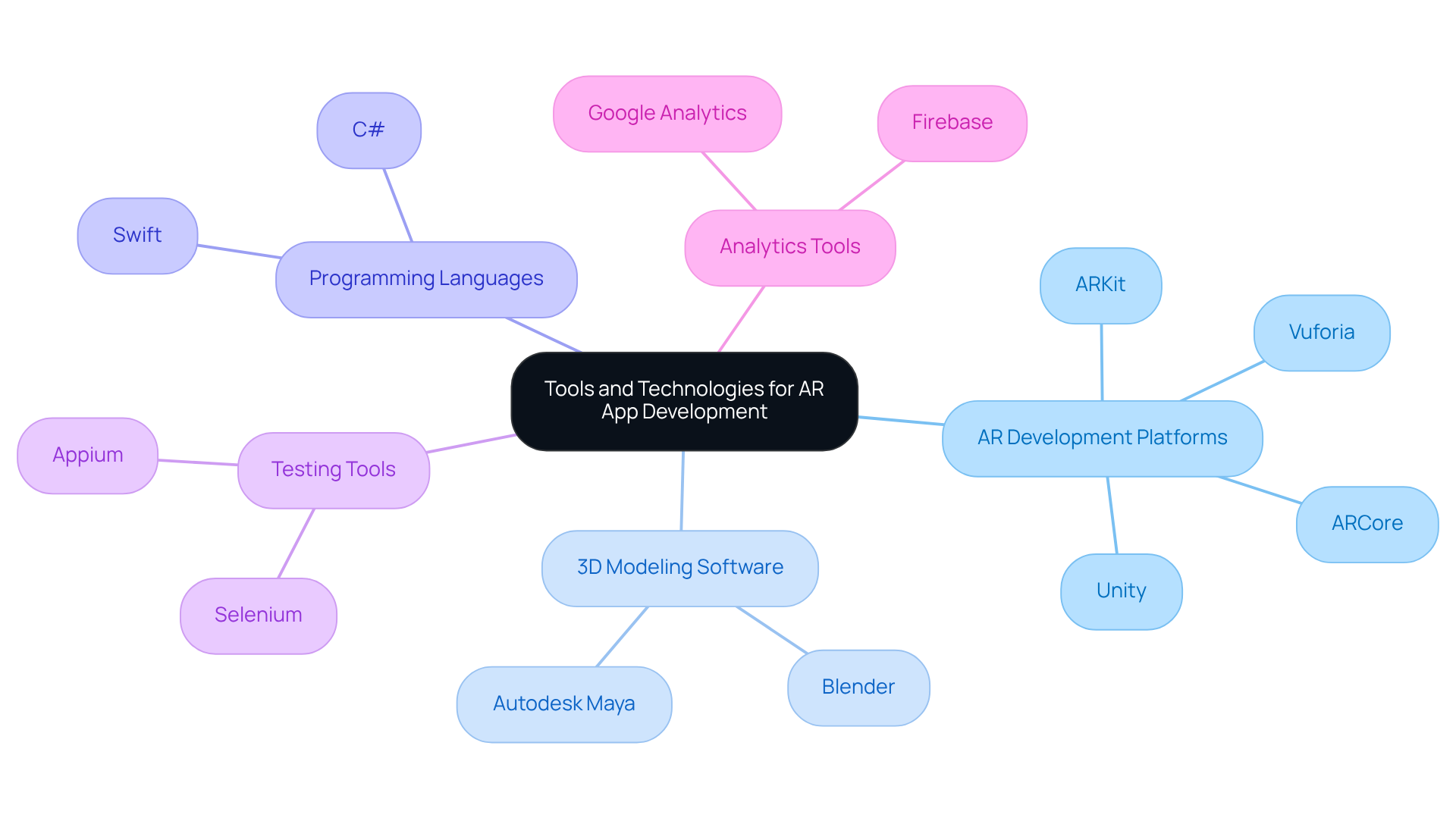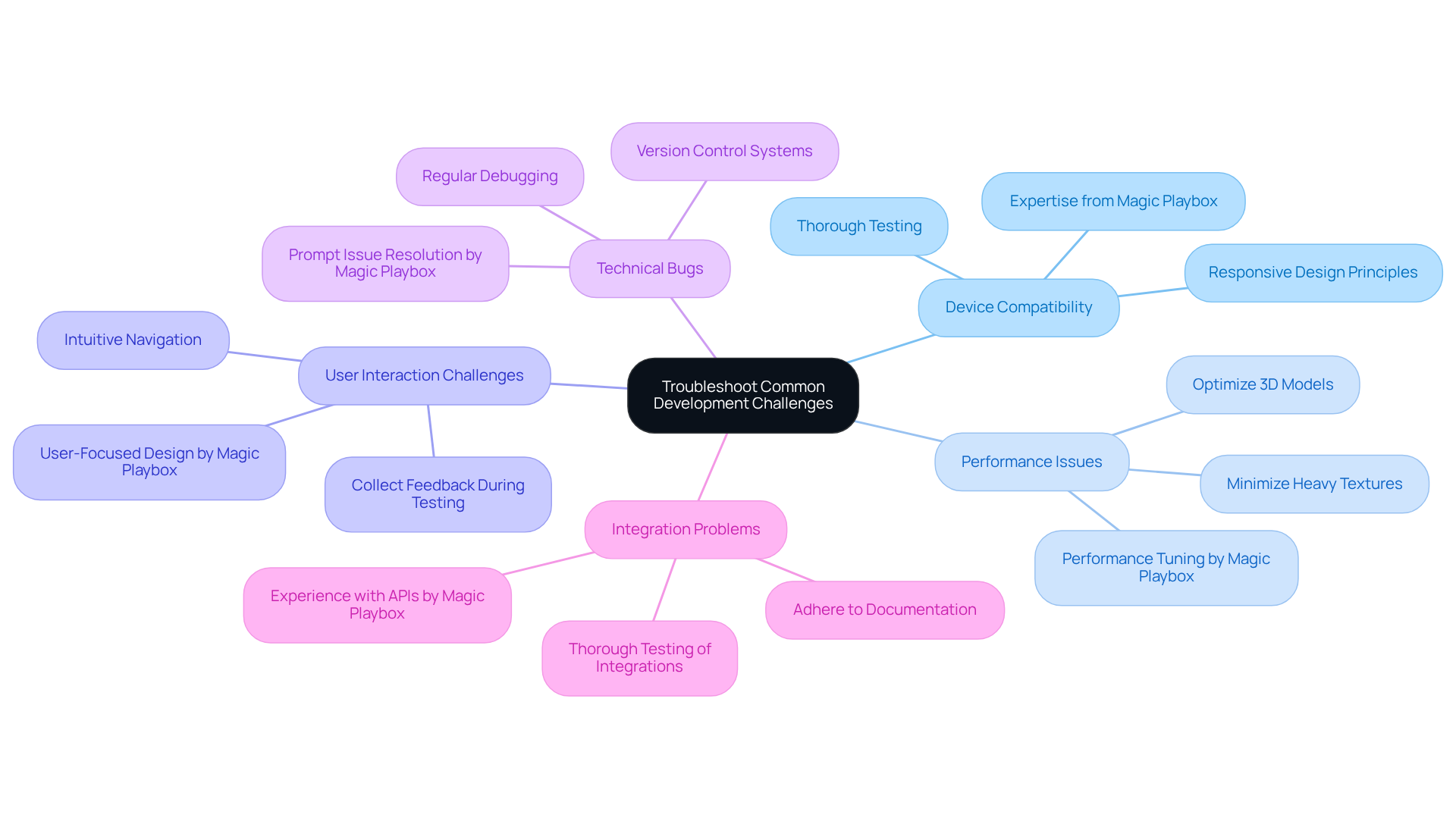Overview
Mastering augmented reality (AR) app development is imperative for those seeking to excel in the XR landscape. This article outlines four essential steps:
- Understanding AR fundamentals
- Following a systematic development process
- Selecting the right tools and technologies
- Troubleshooting common challenges
Each step underscores the significance of foundational knowledge, structured planning, appropriate technology choices, and proactive problem-solving. Research indicates that these elements are crucial for creating effective and engaging AR applications, as exemplified by industry leaders like the IKEA Place app. By embracing these proven strategies, developers can significantly enhance their AR projects and drive innovation within their organizations.
Introduction
Mastering augmented reality app development transcends mere technical skills; it represents a pivotal opportunity to redefine user interactions with their environments. As AR technology advances at an unprecedented pace, developers who understand its core principles can craft immersive experiences that engage audiences across diverse industries.
However, the path is laden with challenges—ranging from device compatibility to performance optimization—that can obstruct even the most groundbreaking ideas.
How can aspiring developers effectively navigate this intricate landscape and transform their visions into reality?
Understand Augmented Reality Fundamentals
To master AR app development, it is crucial to grasp the essential concepts:
- Definition of Augmented Reality: Augmented reality enhances interaction by overlaying digital information onto the real world, enabling individuals to engage with their environment in innovative ways.
- Types of AR: Familiarize yourself with the two primary types of AR: marker-based AR, which utilizes visual markers to trigger digital content, and location-based AR, which leverages GPS data for context-aware interactions.
- Participant Engagement: Explore the various methods through which individuals interact with AR content, including gestures, voice commands, and touch. These interactions contribute to a more immersive experience.
- Key Technologies: Understand the technologies that power AR, such as computer vision, simultaneous localization and mapping (SLAM), and depth tracking. These are crucial for creating seamless interactions.
- Applications of AR: Investigate the diverse applications of AR across different sectors, particularly in e-commerce, where it enhances customer interaction and boosts sales by allowing individuals to visualize products in their own surroundings.
By mastering these fundamentals, you will be well-equipped to navigate the complexities of augmented reality app development and harness its potential to transform interactions. Furthermore, consider how Magic Playbox applies these principles in its innovative AR solutions, enhancing brand engagement and customer loyalty across marketing, e-commerce, and education.

Follow the Step-by-Step Development Process
The development of an AR app can be systematically approached through several key steps:
- Ideation and Conceptualization: Begin by defining the purpose of your app, identifying your target audience, and outlining the key features that will captivate users.
- Design and Prototyping: Create wireframes and prototypes to visualize the interface and interaction. Utilize tools such as Figma or Adobe XD during this phase.
- Development: Select a programming language and AR framework—such as Unity with Vuforia, ARKit for iOS, or ARCore for Android—to commence coding your app. Implement the features defined in your initial concept.
- Testing: Engage in thorough testing to identify bugs and ensure the app functions as intended across various devices. Employ both automated and manual testing methods.
- Deployment: Prepare your app for launch by adhering to the guidelines of app stores (Google Play, Apple App Store) and submit your software for review.
- Post-Launch Support: After launching, actively gather user feedback and make necessary updates to enhance the app's performance and user experience.
By following these steps, you will systematically engage in augmented reality app development to create a robust AR application that meets industry standards and user expectations.

Choose the Right Tools and Technologies
When developing an AR app, it is essential to consider the following tools and technologies:
-
AR Development Platforms: Choosing the right platform is critical. Leading options include Unity, ARKit, ARCore, and Vuforia. Unity stands out for its adaptability and extensive community support, making it ideal for both 2D and 3D projects. Meanwhile, ARKit and ARCore provide robust features tailored for iOS and Android, respectively, offering advanced motion tracking and environmental understanding. Vuforia excels in real-time recognition and tracking, making it a preferred choice in industrial applications.
-
3D Modeling Software: Employing powerful tools such as Blender or Autodesk Maya is vital for creating high-quality 3D models that enhance your AR experience. The integration of detailed 3D assets significantly boosts user engagement and interaction. Industry leaders emphasize that effective 3D modeling is crucial for crafting immersive AR experiences.
-
Programming Languages: Proficiency in programming languages like C# for Unity or Swift for ARKit is essential. Mastering these languages enables you to code your application effectively, leveraging the full capabilities of your chosen platform.
-
Testing Tools: Implementing testing frameworks such as Appium or Selenium automates testing processes, ensuring your app remains bug-free and performs optimally across devices. Thorough testing is indispensable for delivering a seamless experience to users.
-
Analytics Tools: Integrating analytics tools like Google Analytics or Firebase allows you to monitor engagement and gather insights for future enhancements. These tools provide invaluable data that can inform updates and elevate the overall quality of your AR app.
By meticulously selecting the right combination of these tools, you can streamline your augmented reality app development process and significantly enhance the quality of your application.

Troubleshoot Common Development Challenges
Augmented reality app development presents several common challenges that require careful consideration. Understanding how Magic Playbox can assist in overcoming these hurdles is essential:
- Device Compatibility: Ensure your app functions seamlessly across various devices by conducting thorough testing on multiple platforms and screen sizes. Implement responsive design principles to adapt your app's layout, accommodating the diverse capabilities of smartphones and tablets. Magic Playbox provides expertise in enhancing applications for various devices, ensuring a consistent interaction.
- Performance Issues: Performance optimization is crucial for customer satisfaction. Reduce the size of 3D models and minimize the use of heavy textures to enhance loading times. Optimizing your code can also prevent lag, a significant concern; research indicates that 32% of individuals are discouraged from interacting with AR activities due to cumbersome devices and technical glitches. Magic Playbox focuses on performance tuning, assisting in the creation of smooth and engaging AR interactions.
- User Interaction Challenges: Prioritize user satisfaction by collecting feedback during testing phases. Focus on creating intuitive navigation and providing clear instructions, as AR product experiences are 200% more engaging than their non-AR counterparts, leading to higher customer interaction and satisfaction. Magic Playbox emphasizes user-focused design, ensuring that AR software is not only functional but also enjoyable to use.
- Technical Bugs: Regular debugging is essential to maintain app functionality. Utilize version control systems like Git to manage changes effectively, allowing you to revert to previous versions if necessary, thus minimizing disruptions in the development process. Magic Playbox's development team is skilled in identifying and resolving technical issues promptly, ensuring dependable software.
- Integration Problems: When integrating third-party APIs or SDKs, adhere closely to the provided documentation and conduct thorough testing of each integration. This diligence helps avoid conflicts that could compromise app performance. Magic Playbox has extensive experience with various APIs and SDKs, facilitating smooth integrations that enhance app functionality.
By proactively tackling these challenges and applying effective strategies, you can improve augmented reality app development and create a successful AR application that fulfills expectations and drives engagement. For instance, the IKEA Place app demonstrates how AR can reduce product returns and enhance customer satisfaction by allowing users to visualize furniture in their space before purchasing—a principle that Magic Playbox applies in its own projects.

Conclusion
Mastering augmented reality app development is a multifaceted journey that hinges on understanding foundational concepts, following a structured development process, selecting the right tools, and effectively troubleshooting challenges. By grasping the nuances of augmented reality—from its definition to its diverse applications—developers can harness its potential to create engaging and immersive experiences.
This article outlines a clear path for aspiring AR developers, emphasizing the importance of ideation, design, and testing in the app development lifecycle. Key technologies and tools such as Unity, ARKit, and Vuforia are highlighted for their roles in enhancing the development process. Moreover, strategies for overcoming common challenges ensure that the final product meets user expectations and industry standards.
Ultimately, the significance of augmented reality app development extends beyond technical execution; it represents an opportunity to revolutionize user interaction across various sectors. By embracing these principles and continuously refining skills, developers can contribute to the evolution of AR technology. This is not just about creating applications that captivate users; it is about driving engagement and satisfaction in an increasingly digital world. The call to action is clear: collaborate, innovate, and lead in the AR space to unlock its full potential.
Frequently Asked Questions
What is augmented reality (AR)?
Augmented reality is a technology that enhances interaction by overlaying digital information onto the real world, allowing individuals to engage with their environment in innovative ways.
What are the two primary types of augmented reality?
The two primary types of augmented reality are marker-based AR, which uses visual markers to trigger digital content, and location-based AR, which utilizes GPS data for context-aware interactions.
How do participants engage with augmented reality content?
Participants can engage with augmented reality content through various methods, including gestures, voice commands, and touch, which contribute to a more immersive experience.
What key technologies are essential for augmented reality?
Essential technologies for augmented reality include computer vision, simultaneous localization and mapping (SLAM), and depth tracking, which are crucial for creating seamless interactions.
What are some applications of augmented reality?
Augmented reality has diverse applications across different sectors, particularly in e-commerce, where it enhances customer interaction and boosts sales by allowing individuals to visualize products in their own surroundings.
How does Magic Playbox utilize augmented reality principles?
Magic Playbox applies augmented reality principles in its innovative solutions to enhance brand engagement and customer loyalty across marketing, e-commerce, and education.




